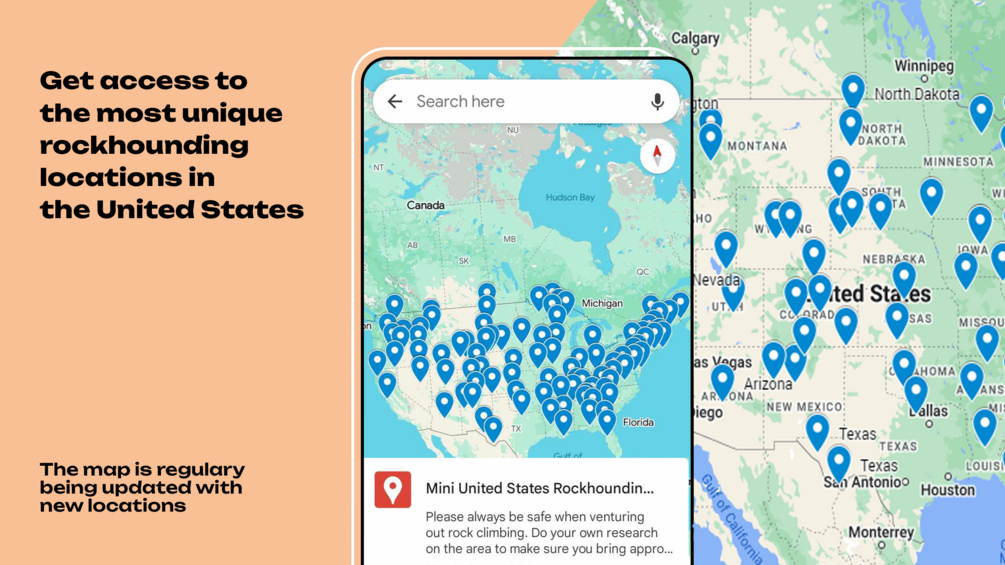Alaska’s wild, untamed beauty isn’t just a feast for the eyes—it’s a treasure trove for rockhounding enthusiasts like you.
With its vast, open landscapes, you’re set for an adventure that’s as rewarding as it is breathtaking. From the rugged beaches to the solitary mountains, Alaska offers an unparalleled rockhounding experience.
You’ll find yourself knee-deep in areas rich with geological wonders, where agates, jade, gold, and fossils are just waiting to be uncovered. Whether you’re a seasoned rockhound or just starting, Alaska’s diverse terrain is your ultimate playground.
Get ready to fill your pack with spectacular finds and memories that are just as precious.
Rockhounding in Alaska offers a diverse experience, with opportunities to find gold in Nome, garnets in Hatcher Pass, and jade in Kobuk Valley. Key locations like Matanuska River and Bethel Quarry offer agates and beryl. Always follow local laws, respect claim areas, and prioritize safety in Alaska’s wild terrain.
Get our FREE United States Rockhounding Map HERE

Alaska Rockhounding Locations
Alaska’s immense terrain is dotted with sites ripe for rockhounding. Each location offers a unique bounty that reflects the state’s geological diversity. As you plan your Alaskan rockhounding adventure, focusing on specific areas will enhance your chances of incredible finds.
Nome
A hot spot for gold panning, Nome’s beaches are famous for their glittering finds. Ensure you’re aware of local rules and respect claim areas.
- Casual Beach: Known for fine placer gold.
- Anvil Creek: Site of Alaska’s largest gold nugget find.
Hatcher Pass
Just north of Palmer, this area is a habitat for garnets and other semi-precious stones. Access to rockhounding sites is generally open during the summer months.
- Independence Mine State Historical Park: Explore the talus slopes for quartz varieties.
- Fishhook Creek: Scour the stream beds for garnets.
Matanuska River
The erosive power of this river uncovers treasures like agates and petrified wood. You’ll find rockhounding access points along the Glenn Highway.
- King Mountain: Hunt for red jasper among the river gravels.
- Chickaloon Formation: Search for leaf imprints within the petrified wood specimens.
Kobuk Valley
North of the Arctic Circle, Kobuk Valley is famous for its jade. Kobuk River’s bends and gravel bars are your best bets for finding sizable jade pieces.
- Dahl Creek: A renowned location for large jade boulders.
- The Great Kobuk Sand Dunes: Surprisingly, these dunes can yield jade nuggets.
When visiting these locales, always prioritize safety and environmental stewardship. Also, be sure to verify access rights and land ownership to avoid trespassing on private claims or protected areas. Overlooking these aspects can not only lead to legal troubles but also spoil the very environment you’re there to enjoy. Remember to carry the right tools, dress for Alaskan weather, and respect the wilderness. Your mindful exploration is key to a rewarding rockhounding experience in Alaska.
What Gemstones are Found in Alaska?

Alaska’s vast landscape isn’t just stunning – it’s a treasure trove for gemstone hunters. As you traverse this wild and rugged terrain, you’re likely to encounter a variety of precious and semi-precious stones, each with unique characteristics and allure.
Jade, Alaska’s state gem, can be particularly abundant. This tough mineral, valued for its beauty and durability, has been used by indigenous peoples for centuries. Your chances of finding jade are higher in the Kobuk Valley, a spot known for its dark green nephrite jade nodules.
If it’s color you’re after, don’t miss out on the quest for garnets. These are commonly found in metamorphic rocks and come in a vast array of colors from deep red to vibrant green. Wrangell Island and the shores of the Stikine River are hotspots for garnet seekers.
Amongst the more thrilling finds are gold-bearing quartz, which is as precious as it is beautiful. Spotting quartz with visible veins of gold is remarkable, and while it’s a rarer find, it’s definitely possible, especially near old mining areas where gold panning was common.
Rhodonite is another gemstone that’s hidden within Alaska’s geological folds. This pink to red manganese silicate mineral makes for an excellent collector’s item and can be found at the Sheep Mountain mine among other locations.
Here’s a summarized table of Alaskan gemstones and their most known locations:
| Gemstone | Known Locations |
|---|---|
| Jade | Kobuk Valley |
| Garnets | Wrangell Island, Stikine River Shores |
| Gold-bearing Quartz | Mining areas |
| Rhodonite | Sheep Mountain mine |
Remember, the journey to uncover these natural treasures is just as rewarding as the find itself. Arm yourself with the right tools and a little bit of patience, and you could unearth gemstones that tell a story millions of years old. Always endeavor to verify land access and regulations, and respect the pristine Alaskan wilderness as you search for these hidden jewels.
What Sedimentary Rocks You Can Find in Alaska?

Exploring the vast expanse of Alaska, you’re bound to encounter an extraordinary variety of sedimentary rocks. These rocks have formed layer upon layer over millions of years and bear the rich history of Earth’s geological processes.
Limestone, one of the most prevalent sedimentary rocks in Alaska, is commonly found in the Brooks Range, an area known for its fossilized remains and ancient reef structures. Here, you could be walking over remnants of marine life that thrived hundreds of millions of years ago.
Heading to the southeastern regions, you’ll notice sandstone and shale formations, particularly throughout the Tongass National Forest. These rocks have been shaped by the weight of overlying materials, compacting sand and mud into strata that whisper tales of an ancient past.
The Kenai Peninsula, with its breathtaking coastal cliffs, offers you an additional chance to find conglomerate and breccia – rocks that are essentially collections of other rock fragments. Rivers carrying sediments from eroding mountains have deposited these materials, eventually cementing them together to form these interesting rocks.
For more specific finds, you can seek out coal in the Matanuska coal fields or the Nenana coal basin. These black, brittle sedimentary rocks are composed primarily of carbon and can be spotted as you traverse these historically-rich mining areas.
In the table below, you’ll see a quick guide to where these sedimentary rocks are typically found in Alaska:
| Sedimentary Rock | Common Locations |
|---|---|
| Limestone | Brooks Range |
| Sandstone | Tongass National Forest |
| Shale | Tongass National Forest |
| Conglomerate | Kenai Peninsula |
| Breccia | Kenai Peninsula |
| Coal | Matanuska & Nenana |
Remember, while these sites offer promising opportunities, always check land access permissions and harness the proper rockhounding etiquette during your excursions. The treasures of the Alaskan terrain await, beneath your feet lies a mosaic of earth’s history ready for you to discover and cherish.
What Metamorphic Rocks are found in Alaska?
Metamorphic rocks reveal tales of geologic transformation that captivate rockhounds. You’ll find Alaska’s landscape to be a treasure trove of such rocks, each with a story etched in time and pressure. Schist, gneiss, and marble are prominent members of this metamorphic family you can uncover here.
Schist is found in abundance across the state and is recognizable by its foliated layers and glistening minerals. It forms under moderate conditions of heat and pressure, leading to a variety of colors and compositions. Searching for schist can offer you gems like garnet, staurolite, and kyanite. Keep your eyes peeled for these sparkly additions in your collection.
Gneiss, speaking volumes of its high-grade metamorphic past, is another rock to watch for. Characterized by its streaked appearance and banded texture, gneiss is a result of extreme pressures and temperatures reshaping the original rock’s structure. In Alaska, gneiss often hosts minerals such as sillimanite and graphite.
Marble, the metamorphosed version of limestone, is cherished not only for its use in sculpture and architecture but also among collectors. Its distinctive swirls and variety of hues are due to impurities in the original limestone. In Alaska, the marble is often found in proximity to schist and gneiss, providing you with a chance to observe the transitions between these metamorphic rocks.
Quartzite, incredibly durable and resistant to weathering, is notable for its glassy appearance and hardness, which surpasses the parent rock, quartz sandstone. It forms from the cementing of quartz grains with siliceous material, transforming under heat and pressure into the resilient rock that it is.
While immersing yourself in the pursuit of these geological wonders, it’s vital to respect the Alaskan wilderness. Carry out all activities with an environmentally conscious approach, ensuring that the pristine condition of these locales remains unspoiled for future generations. With the right tools and a respectful attitude, your rockhounding journey in Alaska can lead to truly remarkable discoveries.
What Igneous Rocks can You Find in Alaska?
Alaska’s geology isn’t just about sedimentary and metamorphic rocks; igneous rocks also make a significant showing. As you delve into Alaska’s vast rockhounding potential, you’ll find an array of these rocks formed from cooled magma or lava.
At the heart of your igneous rock-hunting escapades is the volcanic belt along the Alaska Peninsula and the Aleutian Islands. Here, volcanic activity has given birth to rocks like basalt and andesite. These areas are often accessible by boat, and the effort to reach them is rewarded with unique specimens that tell stories of Alaska’s fiery past.
Basalt, a common volcanic rock, is found in these regions and is often characterized by its fine grains and dark color. In contrast, andesite presents with a slightly lighter color due to its intermediate silica content. Both rock types often contain visibly embedded minerals such as olivine and pyroxene, making them fascinating to examine up close.
In Alaska’s interior, near the Wrangell-St. Elias National Park, your adventure might lead you to discover rhyolite, a lighter-colored rock with high silica content, indicative of more explosive volcanic activity. Rhyolite’s varied appearance, from smooth and glassy to richly textured with crystals, can be quite captivating.
Move northwards to the Brooks Range and you could stumble upon the ultramafic rock peridotite. Unearthing a piece of this dense, dark rock might even yield peridot, the gem-quality variant of the mineral olivine, which rockhounders highly prize for its green hue.
Don’t forget to scout out the igneous intrusions such as granite and diorite, which are a staple in Alaska’s interior and southeastern regions. These plutonic rocks form deep beneath the Earth’s surface and are later exposed through erosion. Their coarse grains and array of minerals like quartz, feldspar, and mica are excellent for rock collections.
When rockhounding for igneous rocks in Alaska, it’s key to respect private property and land regulations. Always seek permission if you’re venturing onto private lands and be sure to leave no trace behind in these pristine natural environments.
Panning for Gold in Alaska
Embarking on a gold panning adventure in Alaska offers a thrilling throwback to the days of the Gold Rush. The state’s rich deposits draw enthusiasts from around the world eager to try their luck. Whether you’re a seasoned prospector or new to the pursuit, Alaska’s streams and rivers hold potential treasures.
Nome, Fairbanks, and Juneau are well-known hotspots for gold panning. These areas have a history of hefty gold finds and continue to attract those with a keen interest in adding to the tally. Your chances of success improve with research on local gold-panning tours and the best seasons for activity. Remember that patience and persistence are your best allies here.
Before you head out, it’s essential to understand the legalities. Certain areas require permits or are off-limits to panning. Check with the Bureau of Land Management and the Alaska Department of Natural Resources for the most up-to-date information on regulations. This preparation ensures you’re panning within the boundaries of the law.
When you’re ready to start, here’s what you need:
- A gold pan, preferably with ridges on the side to trap gold flakes
- A shovel or trowel for digging
- A classifier, which is a mesh screen to help remove larger rocks and debris
- A snuffer bottle or tweezers to pick up the fine gold
As you submerge your pan in the water and sift through the sediments, keep an eye out for the telltale glint of gold. Patience is key; it’s a meticulous process that can take some time. The experience itself, amidst Alaska’s stunning natural beauty, can be as rewarding as any find.
Remember, prospecting in Alaska isn’t just about the gold—it’s about the adventure. The Last Frontier holds a myriad of geological marvels, from the sedimentary rocks discussed earlier to the captivating experience of gold panning. Keep your enthusiasm high, and you might just come away with a golden token of your Alaskan adventure.
Rocks and Minerals Found in Alaska
When embarking on your rockhounding journey in Alaska, you’ll be amazed at the diversity of rocks and minerals that the state has to offer. From the rugged coastlines to the vast interior, each region holds its unique geological treasures just waiting to be discovered.
Quartz variants are widely located across Alaska, with the potential to find everything from clear crystals to rosy pink specimens. These durable minerals are especially prevalent in areas with hydrothermal veins. In contrast, garnets, known for their deep red hue, can be found in metamorphic rocks and are not uncommon in the state’s schist formations.
Alaska is also home to impressive copper ore deposits, with minerals like chalcopyrite and malachite appearing in the state’s greenstone belts. Meanwhile, galena, a source of silver and lead, may be discovered in quartz veins, providing a rewarding find for those who are patient.
Here’s a snapshot of what you might find in specific areas:
| Location | Minerals/Rocks |
|---|---|
| Brooks Range | Copper, Jade |
| Nome | Gold |
| Southeastern | Garnet, Quartz |
| Alaska Peninsula | Obsidian |
Prospectors have also been delighted by jade discoveries in the Kobuk Valley. Alaska’s jade, noted for its immense quality and size, remains a highly sought-after stone.
As you explore the Last Frontier, be sure to venture out to the beaches. The Kenai Peninsula, for instance, offers a bounty of interesting rocks and minerals, with agates and volcanic glass frequently washed ashore.
Remember that part of rockhounding’s allure lies in the surprise—you never know exactly what you’ll turn up in the Alaskan wilderness. Whether it’s on a remote hiking trail or a pebbly beach, the variety of geological finds in Alaska is rich and constantly replenishing, offering an endless adventure for rock enthusiasts. Keep your eyes peeled for signs of mineral deposits, and be ready to explore off the beaten path to uncover Alaska’s hidden geologic wonders.
Where Can I Find Fossils in Alaska?
Alaska, a haven for rockhounds, isn’t just about the present; it’s a gateway to the distant past. If you’re on the hunt for fossils, you’re in luck—Alaska’s vast and varied landscapes are brimming with them. Fossilized remains of both plants and animals that lived millions of years ago are waiting for you to uncover them.
Liscomb Bone Bed near the Colville River in the North Slope is an extraordinary site, famous for fossilized bones of dinosaurs like the Hadrosaur. The permafrost and bluff erosion make it an ideal location, but ensure you’re prepared for the remote conditions. You might also want to check out the beaches of Nome, where marine fossils emerge from the shifting sands.
For plant enthusiasts, the Chignik and Aleutian Islands are treasure troves of fossilized leaves and wood. These areas offer a glimpse into ancient forest ecosystems. However, remember that some sites may be on private lands or protected areas, so always check for permits and regulations.
- Look for ammonite and belemnite fossils on the Kenai Peninsula.
- Explore the shale outcrops along the Yukon River for traces of ancient marine life.
- Scour the Talkeetna Mountains for fossilized coral and brachiopods.
Safety is key when fossil hunting in these rugged terrains—be mindful of tides, weather, and bear activity. Moreover, while the excitement of discovery is a big draw, it’s important to recognize that the collection of vertebrate fossils on public land may require a permit, and in many cases, collecting is strictly limited to scientific research.
To really get the most out of your Alaskan fossil-finding journey, consider joining a guided tour or contacting local museums and universities for information on paleontological sites and digging opportunities. This way, you’re not just searching blindly; you’re enriching your experience with expert knowledge and contributing to the understanding of Alaska’s prehistoric past.
Alaska Rockhounding Laws & Regulations
When planning your rockhounding trip in Alaska, it’s essential to familiarize yourself with the local laws and regulations that govern the collection of rocks, minerals, and fossils. State regulations may seem complex, but they’re in place to protect the land and its natural resources. Always ensure you have the necessary permissions and understand the area’s specific rules before you start.
On state lands, you’re generally allowed to collect rocks and minerals for personal use without a permit. However, there are limits on the quantity you can take and restrictions on selling your finds without a commercial license. Here are some quick facts:
- Personal use typically limits you to one gallon of minerals per day.
- Do not use mechanized equipment without authorization.
- Off-limits areas may include national parks, state parks, and native corporation lands.
Surface collecting, such as picking up loose material from the ground, is usually acceptable on public lands. However, when it comes to collecting in national forests, you’ll need to check with the local forest district office for regulations, as each forest may have its own rules. For example, in the Chugach National Forest, rockhounding may be allowed provided you adhere to the following:
| Quantity | Equipment | Permit |
|---|---|---|
| Small | Hand tools only | Not needed |
Areas designated as National Parks are under the strictest rules. You can enjoy the natural beauty of these places, but removing any natural material is prohibited. If you’re caught violating these rules, you may face substantial fines or legal action.
For those interested in fossil hunting, additional laws apply. The Bureau of Land Management (BLM) oversees fossil collection, and currently, vertebrate fossils cannot be collected without a scientific permit. Invertebrate fossils, however, may be collected in reasonable amounts.
By all means explore, but do so responsibly. Contact local authorities or BLM offices for comprehensive, up-to-date information on collecting regulations. Their guidance ensures your rockhounding adventure aligns with preservation efforts and allows everyone to continue enjoying Alaska’s geological treasures for years to come.
Rockhounding Tips for Beginners in Alaska
Gearing Up: Essential Tools for Rockhounding
When you’re just getting started with rockhounding in Alaska, it’s crucial to gear up with the right tools. A sturdy geological hammer or pick is your indispensable partner for chipping away at rock formations. Don’t forget safety goggles to protect your eyes from flying debris. For sifting through loose soil and gravel, a set of classifiers in various mesh sizes can be quite handy. And since many Alaskan treasures lie beneath the surface, a durable shovel or digging tool will serve you well. Here’s a quick checklist for your tool kit:
- Geological hammer or pick
- Safety goggles
- Heavy-duty gloves
- Set of classifiers
- Shovel or digging tool
- Backpack to carry finds
Remember, the right equipment not only makes the hunt more productive but also ensures a safer experience while you’re out on the terrain.
Safety Tips While Rockhounding
As with any outdoor activity in Alaska, safety should be your top priority. Always inform someone about your rockhounding destinations and anticipated return time. Alaska’s weather can be unpredictable; dress in warm, moisture-wicking layers and be prepared for sudden changes. Invest in a pair of good-quality, waterproof boots for both comfort and protection as you traverse rocky shores or muddy riverbanks.
Keep these additional safety pointers in mind:
- Bring a first-aid kit for minor injuries.
- Carry bear spray and know how to use it.
- Stay hydrated and pack enough food for your trip.
- Use a map or GPS device to avoid getting lost.
- Be aware of the tide schedules if you’re exploring coastal areas.
By following these safety tips, you’ll not only enjoy your rockhounding adventure but also ensure that you return home without incident.
Legal Guidelines for Rockhounding Enthusiasts
Understanding the legal guidelines governing rockhounding is crucial to ensure that your explorations are within bounds. Alaska State Laws and Bureau of Land Management (BLM) regulations dictate where you can collect and the quantities allowed. Typically, for personal use, you’re allowed a reasonable amount of collectibles, but be sure to verify the current limits.
Never assume a piece of land is open for rockhounding without checking. Some areas require permits, especially if you’re venturing onto private land or within claim areas. Keep in mind that National Parks are off-limits; removing any natural material from these protected spaces is illegal. Here are key points to remember:
- Verify collection limits and regulations through Alaska State Laws or BLM offices.
- Obtain necessary permits for collecting in certain areas.
- Respect private property rights and seek permission when necessary.
- Understand that selling your finds may require a commercial license.
Staying informed about these guidelines will help you enjoy your hobby without disrupting the environment or infringing on regulations. Always aim to leave the site as you found it, preserving the natural beauty for future rockhounders to enjoy.
Conclusion: Alaska Rockhounding Guide & Map
Alaska’s vast landscape offers a treasure trove of geological wonders just waiting for you to discover.
With the right tools, safety measures, and respect for the land, you’re set for an unforgettable rockhounding adventure. Remember to gear up, stay informed about the local regulations, and most importantly, leave no trace behind. Whether you’re panning for gold or seeking out stunning gemstones and unique sedimentary and metamorphic rocks, Alaska’s natural bounty is unmatched. So grab your map and let your curiosity lead you to the hidden gems that lie in the Last Frontier’s rugged wilderness.
Happy rockhounding!



![Louisiana Rockhounding Sites in [year]: Best Spots & Treasures](https://observationhobbies.com/wp-content/uploads/2024/01/ZdocqQJBdU4beXX3hNxPc-768x439.jpg)


![Kansas Rockhounding Sites in [year]: Best Spots & Treasures](https://observationhobbies.com/wp-content/uploads/2024/01/MEpyAlU09VN0IV9zhK62K-768x439.jpg)
